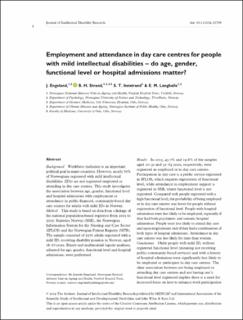| dc.description.abstract | Background
Workforce inclusion is an important political goal in many countries. However, nearly 70% of Norwegians registered with mild intellectual disabilities (IDs) are not registered employed or attending in day care centres. This study investigates the association between age, gender, functional level and hospital admissions with employment or attendance in public financed, community‐based day care centres for adults with mild IDs in Norway.
Method
This study is based on data from a linkage of the national population‐based registries from 2013 to 2015: Statistics Norway (SSB), the Norwegian Information System for the Nursing and Care Sector (IPLOS) and the Norwegian Patient Registry (NPR). The sample consisted of 2370 adults registered with a mild ID, receiving disability pension in Norway, aged 18–67 years. Binary and multinomial logistic analyses, adjusted for age, gender, functional level and hospital admissions, were performed.
Results
In 2015, 45.7% and 19.6% of the samples aged 20–31 and 52–63 years, respectively, were registered as employed or in day care centres. Participation in day care is a public service registered in IPLOS, which requires registration of functional level, while attendance in employment support is registered in SSB, where functional level is not registered. Compared with people registered with a high functional level, the probability of being employed or in day care centres was lower for people without registration of functional level. People with hospital admissions were less likely to be employed, especially if they had both psychiatric and somatic hospital admissions. People were less likely to attend day care and open employment only if they had a combination of both types of hospital admissions. Attendance in day care centres was less likely for men than women.
Conclusions
Older people with mild ID, without registered functional level (meaning not receiving public community‐based services) and with a history of hospital admissions were significantly less likely to be employed or participate in day care centres. The clear association between not being employed or attending day care centres and not having one's functional level registered implies there is a need for increased focus on how to enhance work participation among people with mild IDs who are not within the system of receiving public services. | en_US |

